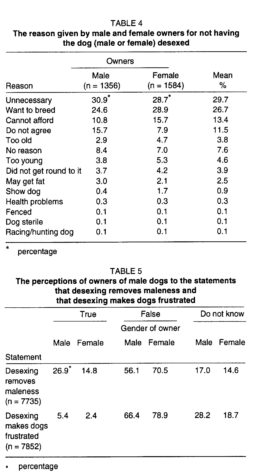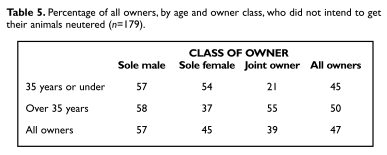Despite public support in most parts of the world, certain groups still withhold hesitation in spaying and neutering their pets. People supply different reasons for opposing pet sterilization based on their age, gender, marital status, and geographical location, indicating that there are likely some cultural influences on these beliefs. Attitudes of certain regions and demographics on the issue can be gathered by surveying the population in those areas. I will touch on a few surveys conducted in different parts of the globe in order to highlight the varying ideology behind opposition in these areas.
Brisbane, Australia
A study conducted on the population of Brisbane in 1991 sought to determine 1) what percentage of owners had their pet dogs spayed or neutered 2) what reasons owners had for not fixing their pets 3) trends in gender demographics on these statistics (Blackshaw & Day, 1994).
Based on the answers collected from owners that did not desex their dog, several trends were observed in the beliefs of certain groups within the population. For example, women were more likely than men to say that they did not fix their dog because they could not afford it (15.7% vs. 10.8%), and men were more likely than women to answer that they simply did not agree with desexing their dogs (15.7% vs. 7.9%) (Blackshaw & Day, 1994). Not surprisingly, male owners of male dogs were twice as likely than female owners of male dogs to agree with the statement “desexing emasculates and frustrates my dog” (Blackshaw & Day, 1994). Below I’ve included two tables from the study showing the popularity of different reasons according to gender. Granted this survey took place in 1991 so it is probably not terribly indicative of the attitude demographics of Brisbane today, but it can give us a sense of the trends in attitudes among this culture.

Trends in attitudes toward refusing pet sterilization by gender in Brisbane, Australia 1991 (Blackshaw & Day, 1994).
Bahamas
After completion of the survey in Brisbane, a follow-up study was conducted on pet owners in the population in the Bahamas. The results of this survey were fundamentally different from those of the Brisbane survey in several ways. First, there was no significant disparity in neutering rates between sole male and sole female pet owners (Fielding, Samuels, & Mather, 2002). Instead, researchers found that young owners and sole owners were less likely to neuter their pets on average than old or partnered owners (Fielding et al., 2002).

Percentages of people opposed to spaying or neutering their pets by age and partner status (Fielding et al., 2002).
The reasons provided by participants for refusing to neuter or spay their animals differed from those in Australia as well. In the Bahamas survey, the most common reason for not sterilizing one’s pets was to preserve them for breeding, followed by age constraints of the animal (Fielding et al., 2002).
Taiwan
I’ve cited Taiwan in other sections for its abnormally low pet sterilization rate (~20%) and relatedly high population of stray dogs. When asked about their reasoning behind not spaying or neutering their dogs, the majority of Taiwanese pet owners answer by saying it is because of expense and “too much trouble” (Hsu et al., 2003). Another possible influence here is that reportedly many Taiwanese veterinarians refuse to perform the procedure out of fear the diminished dog population will reduce the amount of business they get (Hsu et al., 2003). This, to me, appears less likely to be a major contributor, as gonadectomies are two of the most common procedures all veterinarians are trained to do. The idea that they would all break their veterinarian’s oaths and refuse to perform one of the most crucial and common surgeries they are trained for seems a bit ridiculous. However, it may just seem ridiculous from a Western perspective, and could actually be a prevalent issue in other parts of the world.
